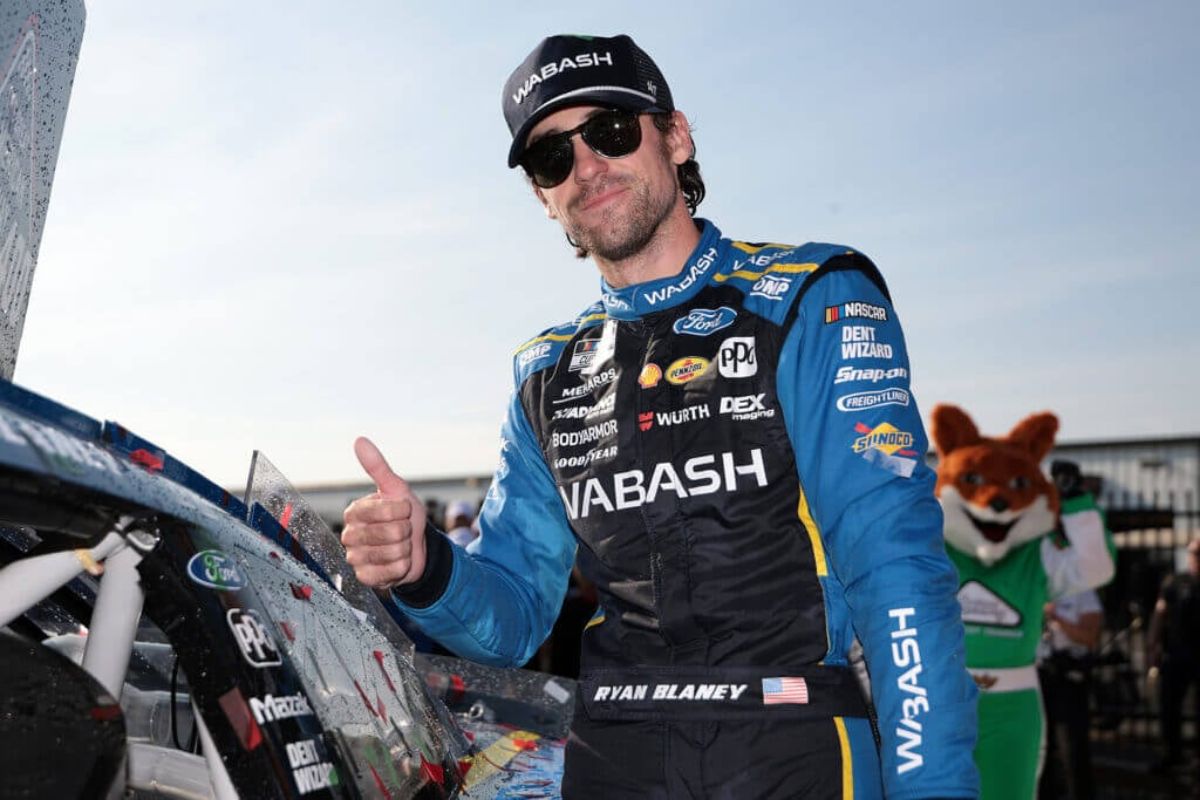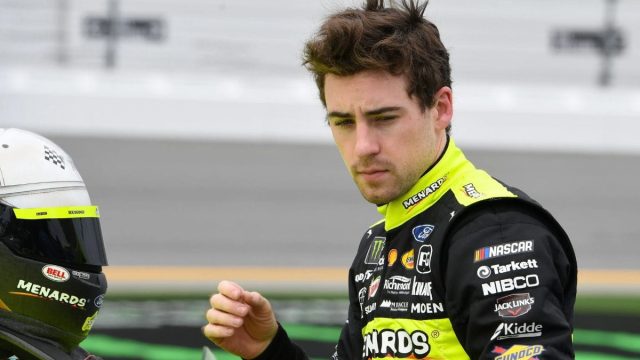Ryan Blaney Rages Against NASCAR: Ryan Blaney‘s recent criticism of NASCAR’s new aerodynamic package highlights a growing tension within the sport, as drivers struggles with notable changes that threaten the essence of competitive racing. His pointed question, “why the hell are we doing that?” encapsulates a broader discontent regarding the impact on speed and racing dynamics. While Blaney previously expressed support for innovations in 2021, his current stance raises critical questions about how NASCAR can balance modernization with the needs of both drivers and fans. What implications might this tension have for the future of the sport?
Key Highlights
- Ryan Blaney expressed frustration with NASCAR’s new aerodynamic package, questioning its rationale and impact on the racing experience.
- The recent changes have led to significantly reduced qualifying speeds, diminishing excitement for fans and competitors alike.
- Blaney highlighted that the previous aerodynamic package at Michigan facilitated competitive racing, allowing for better driving tactics and skill application.
- He pointed out the divide between driver preferences for low downforce and high horsepower versus fan desires for high downforce and low horsepower.
- Blaney’s comments reflect broader concerns within the NASCAR community regarding the balance between innovation and tradition in the sport.
Season’s Innovations and Criticism
The ongoing tension between innovation and tradition has become a defining characteristic of NASCAR’s current season. This season, NASCAR has undertaken several maneuvers aimed at improving the sport’s competitive edge. Significantly, the favorable tire experiment with Goodyear stands out as a potential success. However, the overwhelming response to most other innovations has been largely critical, underscoring a disconnect between the governing body and its drivers.
The introduction of the Next-Gen car has been particularly contentious, with multiple issues drawing the ire of competitors. Drivers have expressed frustration over design flaws and inconsistencies that seem to undermine the integrity of racing. For instance, the recurring problems with missing pylons have disrupted races, leading to calls for greater accountability and more rigorous testing before implementation.
This season’s innovations have not only challenged the drivers’ adaptability but have also raised questions about racing safety and fairness.
Moreover, the recent performance of Sheldon Creed, who secured the Michigan Xfinity pole, further highlights the contrast of emerging talents against a backdrop of persistent criticism. As drivers continue to voice their concerns, it becomes increasingly evident that NASCAR must find a delicate balance between pushing technological boundaries and respecting the sport’s rich heritage.
The ongoing discourse surrounding these innovations reveals the complexities of modern motorsports, where advancements must improve the competition rather than detract from it. As the season unfolds, the examination of NASCAR’s innovations will certainly intensify, shaping the future path of the sport.

New Aerodynamic Package and Ryan Blaney’s Reaction
NASCAR’s introduction of a new aerodynamic rules package this season has ignited considerable backlash, particularly from veteran driver Ryan Blaney. The new package was initially implemented at Phoenix and has since been criticized for diminishing the competitive spectacle that fans expect. Remarkably, the revisions have particularly affected shorter racetracks by lowering downforce, which is a departure from traditional setups that prioritize speed.
At Michigan International Speedway, a venue typically characterized by its high-speed racing, the impact of the new package was glaringly evident. The pole qualifying for the Xfinity series saw speeds plummet by 18 miles per hour compared to the previous year, with Sheldon Creed clocking in at just 171.645 mph. This reduction has raised alarms about the general racing experience, as fans and drivers alike thrive on high-speed competition and overtaking opportunities.
Blaney’s discontent was palpable when confronted with the news of the diminished speeds. His incredulous response—“I didn’t even know that… why the hell are we doing that?”—reflects a broader frustration within the driver community regarding the direction NASCAR is taking.
The decision to implement these aerodynamic changes seems counterintuitive, particularly at a track like Michigan, where the expectation is for thrilling, high-stakes racing. As the season progresses, it remains to be seen how these alterations will influence not only race outcomes but also the sport’s appeal to its dedicated fanbase.
Blaney’s Discontent with the Package
Amid growing frustrations, Ryan Blaney articulated his dissatisfaction with the new aerodynamic package, emphasizing its adverse effects on the racing experience at venues like Michigan International Speedway. Blaney, a previous race winner at Michigan, expressed confusion over the rationale behind altering a package that had previously delivered compelling racing. He stated, “I try to pack race in Speedway races…you need to do that at these places. This place puts on a fine show with the normal package.” His remarks highlights a fundamental concern regarding the package’s impact on competitive dynamics.
“Especially in those cars, you kind of get to left rears and get people loose. That racing was fine, I don’t know the explanation for why they would change that up.” – Blaney
Historically, Michigan has served as a testing ground for different aerodynamic configurations, particularly in 2016 when NASCAR introduced substantial downforce reductions.
However, Blaney’s contention lies in the observation that the changes have not yielded enhancements in race quality. He noted that the previous package allowed for more nuanced driving, enabling drivers to maneuver effectively and create thrilling moments, particularly through left-side tire management. The alteration, he argues, detracts from this skillful interplay, reducing the opportunity for drivers to showcase their abilities.
Blaney’s Positive Review in 2021
Blaney’s earlier endorsement of NASCAR’s aerodynamic package in 2021 sharply contrasts with his current frustrations. In that season, the package was essential in facilitating competitive racing, exemplified by Blaney’s victory at Michigan.
During this race, he initially struggled to contend with the leading drivers, such as Kyle Larson and his Hendrick Motorsports teammates. However, the dynamics shifted dramatically during the final restart, demonstrating the package’s effectiveness in promoting tactical racing.
The design, characterized by a larger spoiler, generated notable drag, which played a vital role in the race’s unfolding. Blaney benefited from a timely push from Kyle Busch, which allowed him to surge ahead.
The ensuing scenario saw the leaders bunched together behind him, illustrating the package’s capacity to create thrilling moments of blocking and mirror driving—a hallmark of NASCAR’s competitive spirit.
Blaney’s support for this aerodynamic configuration stemmed from its ability to improve the racing spectacle, yielding an environment where skillful driving and tactical maneuvering were paramount.
As he now voices discontent with the current iteration, it prompts reflection on the evolving landscape of NASCAR’s regulations and their tangible impact on driver experiences and fan engagement.
Blaney’s Justification of the Package
The evolving dynamics of NASCAR’s aerodynamic package have sparked a complex dialogue among drivers, with Ryan Blaney serving as a prominent voice in the discussion. Following his victory at the FireKeepers Casino 400, Blaney articulated a nuanced perspective on the current rules governing the sport. He highlighted a fundamental divide in preferences: while fans have shown a proclivity for a high downforce, low horsepower package, many drivers—including himself—favor a low downforce, high horsepower configuration, which he personally finds more enjoyable to drive.
Blaney’s remarks highlights a critical element of the sport’s evolution; he acknowledges the necessity for adaptability among drivers as NASCAR adapts to different racing formats. His assertion that the contemporary 550-horsepower package demands a distinct approach to racing challenges the notion that this configuration diminishes the skill required to compete. Instead, he posits that it fosters a different kind of racing, one that necessitates a fresh tactical mindset.
“The fans wanted a high downforce package, low horsepower. If you listen to other people, a lot of other people in the garage want a low downforce, high horsepower package. That’s what personally I enjoy driving more. It’s not no-skill (but) it’s a different kind of racing.”
“You have to understand just kind of a different way to approach the race, a different way to drive the car. We’re not all running out there and sipping lemonade while we’re running these 550 packages. It’s a different kind of racing maybe than what it used to be here three years ago with the low spoiler and high horsepower. It’s just changed (and) everyone has had to adapt to it.” – Blaney
Moreover, Blaney’s comments reflect an understanding that the sport is in a state of flux, with drivers needing to recalibrate their techniques to succeed under the current parameters. As the racing community awaits the outcomes of future competitions, such as the upcoming Michigan race, Blaney’s insights serve as a reminder that the debate surrounding the aerodynamic package is both multifaceted and ongoing.

News in Brief: Ryan Blaney Rages Against NASCAR
Ryan Blaney’s criticism of NASCAR’s new aerodynamic package highlights a noteworthy tension between innovation and tradition within the sport. The alterations have not only impacted vehicle performance but also the general spectator experience, raising concerns among drivers regarding competitive integrity. Striking a balance between technological advancements and the essence of racing remains vital for maintaining audience engagement and driver satisfaction, ultimately shaping the future direction of NASCAR.
ALSO READ: Ryan Blaney Celebrates Gianna Tulio’s Birthday with a Heartfelt Post

